
Eriophyllum lanatum, with the common names common woolly sunflower, Oregon sunshine and golden yarrow, is a common, widespread, North American plant in the family Asteraceae.

Claytonia virginica, the Virginia springbeauty, eastern spring beauty, grass-flower or fairy spud, is an herbaceous perennial plant in the family Montiaceae. Its native range is eastern North America. Its scientific name honors Colonial Virginian botanist John Clayton (1694–1773).

Claytonia is a genus of flowering plants native to Asia, North America, and Central America. The vitamin-rich leaves can be eaten raw or cooked, and the tubers can be prepared like potatoes.
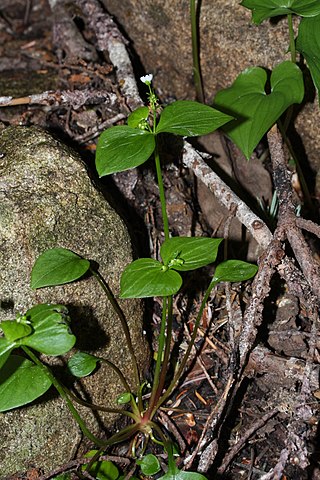
Claytonia sibirica, the pink purslane, candy flower, Siberian spring beauty or Siberian miner's lettuce, is a flowering plant in the family Montiaceae, native to the Commander Islands of Siberia, and western North America from the Aleutian Islands and coastal Alaska south through Haida Gwaii, Vancouver Island, Cascade and Coast Ranges, to a southern limit in the Santa Cruz Mountains. Populations are also known from the Wallowa Mountains, Klamath Mountains, northern Idaho, and The Kootenai. A synonym is Montia sibirica. The plant was introduced into the United Kingdom by the 18th century, where it has become very widespread.

Claytonia lanceolata is a species of wildflower in the family Montiaceae, known by the common names lanceleaf springbeauty and western springbeauty.
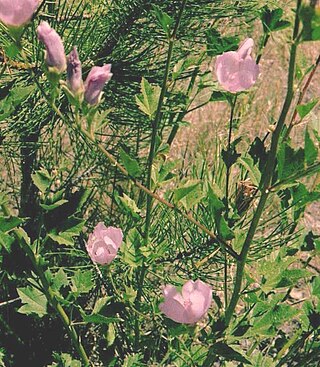
Iliamna bakeri is an uncommon species of flowering plant in the mallow family known by the common names Baker's globe mallow and Baker's wild hollyhock.

Claytonia exigua is a species of wildflower known by the common names serpentine springbeauty and pale claytonia, in the family Montiaceae.
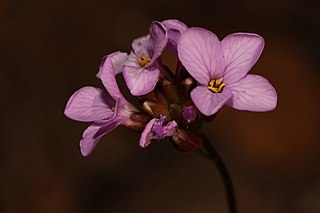
Arabis aculeolata is a species of flowering plant in the mustard family known by the common name Waldo rockcress.
Astragalus californicus is a species of milkvetch known by the common name Klamath Basin milkvetch.
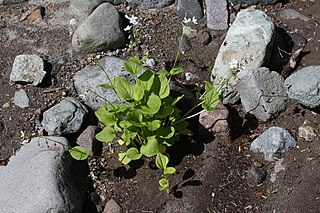
Claytonia cordifolia is a species of wildflower in the family Montiaceae known by the common name heartleaf springbeauty. It is native to western North America from British Columbia to Utah, where it grows in shallow lakes and in streams or springs and wetlands including bogs and fens according to Miller and Chambers (2006). It is a perennial herb growing from a long, budding rhizome and producing an erect stem up to 40 centimeters tall. The basal leaves have oval blades up to 9 centimeters long with heart-shaped bases where they attach to their long petioles. There is also a pair of oval-shaped leaves at a midpoint on the stem. The stalked inflorescence bears up to 12 small flowers with five white petals each about a centimeter long.
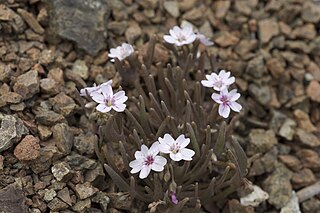
Claytonia gypsophiloides, known by the common names gypsum springbeauty and Coast Range claytonia, is a species of wildflower in the family Montiaceae.

Claytonia megarhiza is a species of wildflower in the family Montiaceae known by the common names fell-fields claytonia and alpine springbeauty. The specific epithet megarhiza is Greek for "large roots".
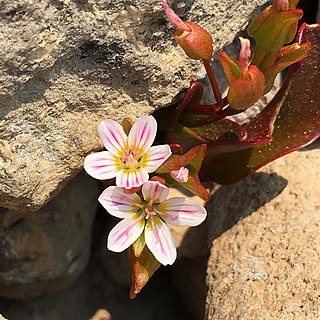
Claytonia nevadensis, known by the common names Sierra springbeauty and Sierra Nevada claytonia, is a species of wildflower in the family Montiaceae. The evolutionary relationship of Claytonia nevadensis to other claytonias is a subject of debate and ongoing genetic studies. Sierra springbeauties are diploid with a chromosome base number of x = 7

Claytonia palustris is a species of wildflower in the family Montiaceae known by the common names Jonesville springbeauty and marsh claytonia. Often mistaken for Claytonia sibirica, the species is diploid with a chromosome base number of x = 6.
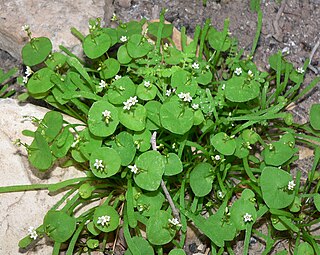
Claytonia parviflora is a species of wildflower in the family Montiaceae known by the common name Indian lettuce. It is native to western North America from southwestern Canada to northwestern Mexico, where it is found in many types of habitat, particularly areas that are moist in the spring.

Claytonia rubra is a species of wildflower in the family Montiaceae known by the common names redstem springbeauty and erubescent miner's lettuce. It is native to western North America from southwestern Canada to the United States of America extending from The Black Hills and western slopes of the Rocky Mountains to the Cascade and Coast Range, Ochoco and Wallowa Mountains south to the Warner Mountains, Yolla Bolly Mountains, and Sierra Nevada and Transverse Ranges [Mt. Pinos and Mt. San Gorgonio], where it is found in coniferous forests and shrublands. This is an annual herb with stems up to about 15 centimeters long. Some individuals may overwinter as biennials. The basal leaves have small rounded to diamond-shaped blades on long, tapering petioles. There are also leaves on the stem which may be rounded or squared and sometimes fuse together to create a bowl around the stem. All the leaves possess blunt (obtuse) tips according to published descriptions and taxonomic treatments. The herbage is red or pink in color at all stages of development. The inflorescence is a dense cluster of up to 30 tiny flowers, each with petals less than 4 millimeters long and white to pink-tinted in color. Together with Claytonia perfoliata and Claytonia parviflora, Claytonia rubra comprises what is almost certainly a polyploid pillar complex based on three diploid species, each occupying a definitive ecological niche
Claytonia umbellata is a species of wildflower in the purslane family known by the common name Great Basin springbeauty. It is native to the Great Basin of the United States, where it grows mainly in subalpine coniferous forests, often on north-facing exposed slopes in the talus. It is a perennial herb growing from a tuberous root up to 5 centimeters wide and a thin taproot. Most of the stem develops underground, as do the petioles of the most basal leaves. Above the ground appear a few oval-shaped fleshy red to green leaves and an inflorescence of up to 12 flowers. Each flower has five magenta to deeply pink-tinted white petals.

Claytonia caroliniana, the Carolina springbeauty, is an herbaceous perennial in the family Montiaceae. It was formerly placed in the Portulacaceae. Its native range is eastern and central North America. It is most commonly found in the New England area of the United States but its habitat extends from Ontario and a northern limit in the Cape Anguille Mountains of Newfoundland and south to Alabama. It grows approximately 6 inches tall in forests of the Appalachian Mountains and piedmont
Claytonia tuberosa, commonly known as Beringian springbeauty or tuberous springbeauty, is a species of flowering plant in the family Montiaceae. It is a perennial herb indigenous to Alaska, British Columbia, Northwest Territories, and the Yukon of North America, westward to East Asia–Siberia. The perennial grows from a globose tuberous root to a height of 15 centimetres (6 in) and bears several hermaphrodite white flowers on stems bearing a single pair of petiolate cauline leaves. Its closest relative is probably Claytonia virginica.

Claytonia rosea, commonly called Rocky Mountain spring beauty, western springbeauty or Madrean springbeauty, is a diminutive spring blooming ephemeral plant with pale pink to magenta flowers. It grows a small round tuberous root and it one of the earliest wildflowers of spring in its range. It is found in dry meadows in forests of ponderosa and Chihuahuan pines, and moist ledges of mountain slopes of the Beaver Dam Mountains of Utah, Colorado Front Range, and Sierra Madre Occidental, south and east to the Sierra Maderas del Carmen of Coahuila.
















